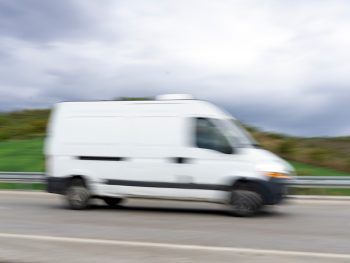Van fleets are “pouring money down the drain” and creating more emissions by not clamping down on aggressive driving styles, new research suggests.

IAM RoadSmart has said that van drivers waste almost £700 a year on fuel and tyres due to their driving style, running into costs of tens of thousands for large fleets. At the same time, drivers are pumping out unnecessary CO2 emissions.
The research from the road safety charity was collated through data from 4,500 participants in its ‘Driving for Work’ training courses.
Behaviour such as excessive speed, accelerating sharply and braking suddenly puts extra strain on the engine, tyres and brake pads, as well as leading to more fuel consumption.
By using eco-driving, the average van driver would save £539 a year in fuel alone and spend up to £144 less on new tyres. Drivers could also cut their CO2 emissions by up to 14%. If a fleet of 100 adopted ‘eco driving’, 69 tonnes of CO2 emissions would be cut; the equivalent produced driving a car around the world 14 times.
Separate research from IAM RoadSmart revealed that drivers of unbranded white vans – the so-called ‘white van man’ – are seen as most likely to show aggressive behaviour, such as tailgating, undertaking and gesticulating.
Out of more than 2,000 IAM RoadSmart motorists surveyed, half thought ‘white van drivers’ were the most aggressive, followed closely by drivers of SUVs.
Almost half believe that white van drivers were most likely to disobey road signs, park inconsiderately or ignore traffic lights.
Nicholas Lyes, IAM RoadSmart director of policy and standards, said: “While it’s understandable that some traders or couriers will spend lengthy periods of the day on the road leading to inevitable frustrations, this can lead to unsafe driving and increased costs.
“When the statistics show that work journeys account for nearly one in three deaths on UK roads, it is unsurprising that driving for work is one of the most dangerous activities workers can do.
“Driving aggressively is one of the most pointless things someone can do. It’s dangerous, stresses out the person doing it, angers other road users, costs you more money and will not get you where you want to be any more quickly. In a nutshell, you are burning money, creating more emissions and risking a crash for absolutely no benefit.
“The data from our Driving for Work course shows that those companies not taking fleet training seriously are essentially pouring money down the drain by letting negative driver behaviours go unaddressed.”
Lyes added that investing in driving efficiency training would enable businesses to take “impactful steps” towards eliminating poor driver habits and unlocking the big savings that come in doing so, while helping to keep their colleagues safer on the road.
“For independent traders it will help dispel the perception that many have that they are more aggressive than other road users, ridding themselves of the ‘white van man’ stereotype.”
On-road training courses offer the most direct route to improved driver safety, helping employees to develop safer behaviours while bringing direct financial benefits to businesses also.
By supporting drivers in developing a calmer, more efficient driving style, companies can benefit from reduced incidence of collisions and associated downtime, improved fuel economy, and less wear and tear on vehicles. Moreover, those driving for work may benefit from calmer and a less stressful driving.

